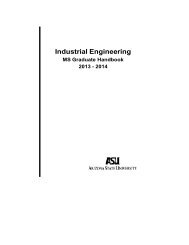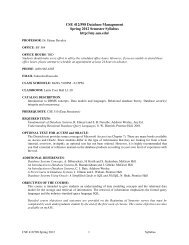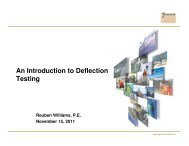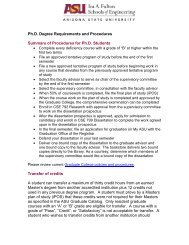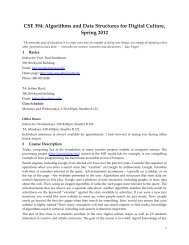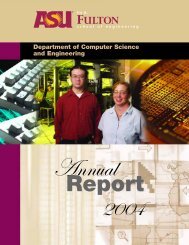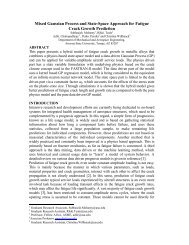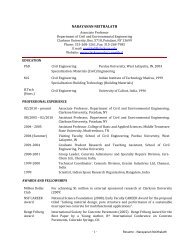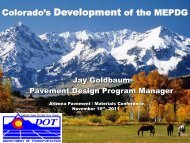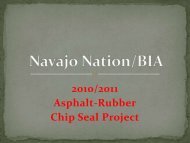Abstract Book - Ira A. Fulton Schools of Engineering - Arizona State ...
Abstract Book - Ira A. Fulton Schools of Engineering - Arizona State ...
Abstract Book - Ira A. Fulton Schools of Engineering - Arizona State ...
Create successful ePaper yourself
Turn your PDF publications into a flip-book with our unique Google optimized e-Paper software.
Organic Fouling <strong>of</strong> Antimicrobial Coated Drinking Water Filter Media<br />
Vanessa Chavez, Civil <strong>Engineering</strong><br />
Graduation: December 2010 Hometown: Chandler, <strong>Arizona</strong><br />
Mentor: Dr. Peter Fox, Civil <strong>Engineering</strong><br />
Grand Challenge: Sustainability and energy<br />
Research investigated the effect <strong>of</strong> coating filtration media with quaternary ammonium compounds on microbial<br />
removal and organic fouling. Filtration media were sand and zeolite, and microbes were Escherichia coli. Media’s<br />
sorption properties were determined by allowing contact time between various masses <strong>of</strong> filtration media and<br />
water containing 20mg/L humic acid. Further analysis was performed by filtering tap water with microbes<br />
through a column packed with media. Results indicate coated sand has superior abilities to remove microbes,<br />
with negligible fouling effects during a 3-hour column test. Coated sand’s sorption properties and inactivity<br />
ability should be investigated to determine any limiting factors.<br />
Using Kinematics to Track Parkinsonian Motor Skill Depletion<br />
Brian Dekleva, Bioengineering<br />
Graduation: May 2011 Hometown: Pottstown, Pennsylvania<br />
Mentor: Dr. Stephen Helms Tillery, Bioengineering<br />
Grand Challenge: Engineer the tools <strong>of</strong> scientific discovery<br />
The aim <strong>of</strong> this project is to develop a system capable <strong>of</strong> quantifying Parkinsonian motor skill depletion in nonhuman<br />
primates. First, a wrist-worn device containing an accelerometer and two infrared LEDs was developed to<br />
measure the parameters <strong>of</strong> motion during a reaching task. A s<strong>of</strong>tware program was then developed to capture<br />
the data, using the infrared function <strong>of</strong> a Wii remote to track the LEDs. Currently a nonhuman primate is being<br />
introduced to the device and motion data will be collected before and after Parkinson’s disease in induced. The<br />
data will then be analyzed to quantify the Parkinsonian symptoms observed.<br />
The Synthesis <strong>of</strong> Nanoparticle-Coated Carbon Microspheres<br />
Matthew Dion, Chemical <strong>Engineering</strong><br />
Graduation: May 2011 Hometown: Phoenix, <strong>Arizona</strong><br />
Mentor: Dr. Bryan Vogt, Chemical <strong>Engineering</strong><br />
Grand Challenge: Energy<br />
A novel route to synthesize nanoparticle-coated carbon microspheres is examined based upon in-situ polymerization<br />
<strong>of</strong> furfural in water Pickering emulsions. Initial studies utilized SiO2 nanoparticles to stabilize the emulsion; increasing<br />
the furfural concentration results in larger nanoparticle-coated microparticles. These microparticles are carbonized<br />
by heating to 800°C in N2 atmosphere. Following this pro<strong>of</strong> <strong>of</strong> concept, this approach has been extended to a<br />
functional nanoparticle: TiO2. Titania@carbon microparticles could potentially be used as electrodes in lithium ion<br />
batteries. Interestingly, much smaller microparticles are formed utilizing TiO2 in comparison to SiO2 nanoparticles<br />
at identical conditions. Future work will examine their electrochemical behavior.<br />
Spring 2010 11



